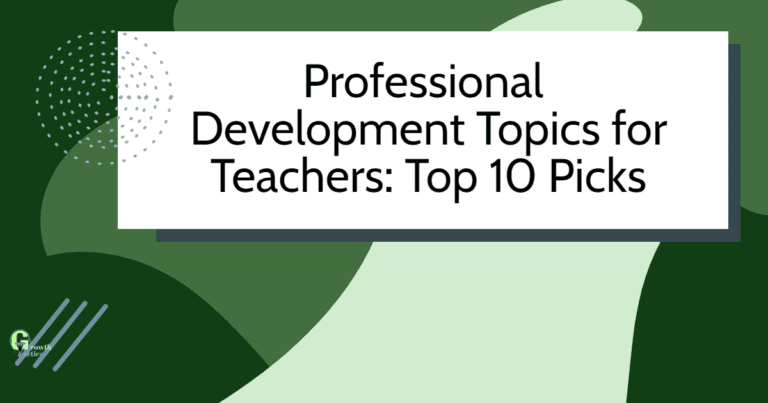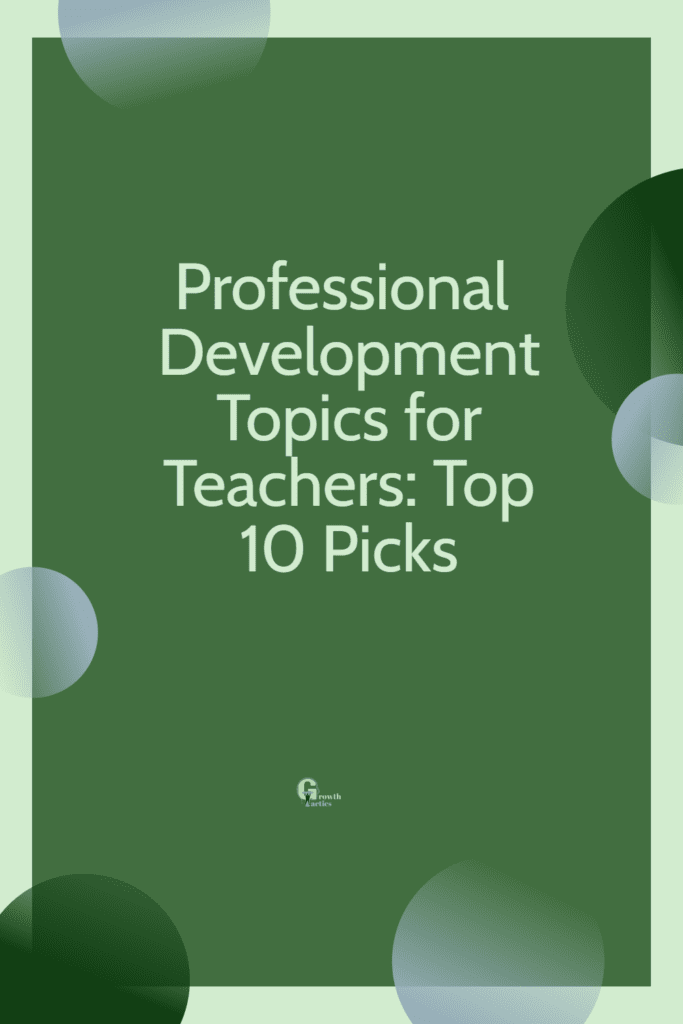Welcome to our blog post on professional development topics for teachers. In today’s ever-evolving educational landscape, continuous growth and learning are essential for educators to stay effective and provide the best possible education for their students. Professional development plays a crucial role in enhancing teaching skills, expanding knowledge, and keeping up with advancements in curriculum design and instructional strategies.
From workshops and conferences to online courses and research-based programs, there is a wide range of options to suit every teacher’s needs and interests. We will also discuss how professional development positively impacts student achievement by equipping teachers with the latest research-backed practices.
So, if you’re looking to enhance your teaching skills or broaden your knowledge base, join us as we dive into the world of professional development topics for teachers.
Jump To Section
Importance of Social-Emotional Learning in Education

Understanding how social-emotional learning contributes to academic success
Social-emotional learning (SEL) is a crucial aspect of education that goes beyond traditional academics. It focuses on developing skills related to self-awareness, self-management, social awareness, relationship building, and responsible decision-making. By promoting social and emotional learning (SEL) in the inclusive education classroom, teachers can help students thrive academically and personally. This can be achieved through incorporating SEL into the curriculum, course materials, and books used in the classroom.
When students are equipped with strong social-emotional skills, they are more likely to engage in their learning and perform better academically. This is because SEL helps students develop a positive mindset, resilience, and the ability to manage stress effectively. When students feel supported emotionally, they are better able to focus on their studies and overcome challenges that may arise.
Exploring strategies to promote emotional intelligence among students
Promoting emotional intelligence among students is a key component of social-emotional learning. Emotional intelligence involves recognizing and understanding one’s own emotions as well as empathizing with others’ emotions. Teachers can implement various strategies to foster emotional intelligence in the classroom.
One effective strategy is teaching students about different emotions and providing them with tools to express and regulate their feelings appropriately. This can be done through activities such as journaling, role-playing scenarios, or engaging in discussions about emotions.
Another strategy is creating a safe and supportive classroom environment where students feel comfortable expressing themselves without fear of judgment or ridicule. By fostering an atmosphere of acceptance and understanding, teachers can encourage open communication and empathy among students.

Strategies for Effective Differentiated Instruction
Differentiated instruction is a teaching approach that recognizes and responds to the diverse learning needs of students in a classroom. It involves adapting teaching methods, materials, and assessments to meet the individual needs of each student. This approach is essential because every student learns differently, and it ensures that all students have equal opportunities to succeed.
To effectively implement differentiated instruction, teachers can employ several practical strategies:
Explaining Differentiated Instruction’s Importance
Teachers should start by explaining what differentiated instruction is and why it is important. They can emphasize that not all students learn at the same pace or in the same way. By tailoring their teaching methods to accommodate different learning styles, abilities, and interests, teachers create an inclusive environment where all students can thrive.
Adapting Teaching Methods for Diverse Needs
One key aspect of differentiated instruction is modifying teaching methods to cater to diverse student needs. Teachers can use various techniques such as flexible grouping, tiered assignments, and learning centers. Flexible grouping allows students with similar abilities or interests to work together on specific tasks or projects. Tiered assignments involve providing different levels of complexity based on individual readiness levels. Learning centers offer stations where students can engage in activities aligned with their learning preferences.
Benefits of Personalized Learning Experiences
Differentiated instruction provides personalized learning experiences for students, which has numerous benefits for their academic growth. When students receive instruction tailored to their needs, they are more engaged and motivated to learn. They develop a deeper understanding of concepts and are better able to apply their knowledge in real-world scenarios.
Integrating STEM/STEAM in Teaching
STEM (Science, Technology, Engineering, and Mathematics) and STEAM (Science, Technology, Engineering, Arts, and Mathematics) education have become increasingly significant and relevant in today’s rapidly advancing world. By incorporating these subjects into their teaching practices, teachers can provide students with valuable skills that will prepare them for the future. Let’s explore the significance of STEM/STEAM education and discuss various ways to integrate it into lesson plans.
Significance and Relevance of STEM/STEAM Education
STEM/STEAM education goes beyond teaching individual subjects; it emphasizes critical thinking, problem-solving, creativity, collaboration, and innovation. These are essential skills that students need to succeed in a technology-driven society. By integrating STEM/STEAM activities into their lessons, teachers can create an engaging learning environment that fosters curiosity and encourages students to think outside the box.
Ideas and Resources for Incorporating STEM/STEAM Activities
Incorporating STEM/STEAM activities doesn’t have to be complicated or require expensive materials. Here are some ideas and resources that teachers can use to infuse STEM/STEAM into their lesson plans:
- Design challenges: Provide students with real-world problems or scenarios where they must design solutions using scientific principles or engineering concepts.
- Project-based learning: Assign projects that require students to research, plan, prototype, test, and present their findings or creations.
- Collaborative activities: Encourage teamwork by assigning group projects where students work together to solve problems or complete hands-on experiments.

Culturally Responsive Teaching Practices
Culturally responsive teaching is all about creating inclusive classrooms that honor and celebrate the diverse cultural backgrounds of students. It recognizes that every student brings a unique set of experiences, values, and perspectives to the classroom, and aims to incorporate these into instructional practices. By doing so, culturally responsive teaching promotes cultural awareness, fosters positive relationships, and empowers students to succeed academically.
Defining Culturally Responsive Teaching
Culturally responsive teaching is an approach that acknowledges and addresses the cultural biases present in traditional education systems. It involves adapting instructional strategies to meet the needs of students from different cultural backgrounds. This approach goes beyond simply acknowledging diversity; it actively incorporates multicultural perspectives into curriculum materials and instructional methods.
Importance of Culturally Responsive Teaching
Culturally responsive teaching is essential for creating an inclusive learning environment where all students feel valued and respected. When teachers embrace this approach, they ensure that their instruction aligns with the cultural backgrounds of their students. This helps to break down barriers between home culture and school culture, leading to increased engagement, motivation, and academic achievement.
By incorporating culturally responsive practices into their classrooms, teachers can:
- Foster a sense of belonging: Students who feel seen and heard in the classroom are more likely to engage in learning activities and develop positive relationships with their peers.
- Promote equity: Culturally responsive teaching challenges systemic inequities by providing equal opportunities for all students to succeed academically.

Essential Topics for New Teacher Training
New teachers have a lot on their plates. They are responsible for shaping young minds, creating engaging lesson plans, and managing a classroom full of energetic students. To help them succeed in their role, it is crucial to provide comprehensive training that covers key areas essential to their professional development. Let’s explore some of these topics in detail.
Classroom Management
One of the most important aspects of being an effective teacher is having strong classroom management skills. New teachers should focus on understanding different strategies and techniques to create a positive and inclusive learning environment. This includes establishing clear expectations, implementing behavior management systems, and fostering a sense of community within the classroom.
Some key points to cover during training include:
- Setting up routines and procedures to maintain order and structure.
- Developing strategies to address student misbehavior effectively.
- Promoting student engagement through interactive activities and collaborative learning.
Lesson Planning
Creating well-designed lesson plans is essential for delivering quality instruction. During training, new teachers should learn how to develop effective lesson plans that align with curriculum standards and meet the needs of diverse learners. This includes identifying clear objectives, selecting appropriate instructional materials, and incorporating various teaching strategies.
Here are some important considerations for new teachers when it comes to lesson planning:
- Understanding the importance of pre-assessment to gauge students’ prior knowledge.
- Incorporating differentiated instruction to meet the needs of all learners.
- Utilizing technology tools and resources to enhance teaching and learning experiences.
Supporting Special Needs Students
Inclusive classrooms are a melting pot of diverse learners, including students with special needs. As teachers, it is crucial to understand the unique challenges and requirements of these students in order to create an inclusive learning environment where every child can thrive. Let’s explore some key strategies and considerations for supporting special needs students in the classroom.
Understanding Diverse Needs
Special education students have a wide range of disabilities and diverse needs, which can vary greatly from one student to another. It is essential for teachers to familiarize themselves with these unique needs in order to provide appropriate support. Some common disabilities include learning disabilities, autism spectrum disorders, attention-deficit/hyperactivity disorder (ADHD), and physical disabilities.
To cater to the diverse needs of special education students, teachers should:
- Conduct thorough assessments: Assessments help identify individual strengths and challenges, allowing teachers to tailor their teaching methods accordingly.
- Collaborate with specialists: Working closely with special education professionals can offer valuable insights into specific interventions and strategies that may benefit each student.
- Provide differentiated instruction: Adapting teaching methods, materials, and assessments based on individual abilities ensures that all students can access the curriculum effectively.
Creating an Inclusive Learning Environment
Inclusion means ensuring that every student feels welcomed, valued, and supported in the classroom. To foster inclusivity for special needs students:
- Promote positive peer interactions: Encouraging collaboration among all learners helps build empathy and understanding while fostering a sense of belonging.
- Use visual aids: Visual supports such as charts, diagrams, and graphic organizers can assist students in understanding concepts more easily.

Eco-Friendly and Sustainable Teaching Practices
Incorporating environmental sustainability into teaching practices is an essential aspect of creating an educational environment that promotes eco-consciousness and instills a sense of responsibility towards the environment in students. By exploring ways to integrate sustainable practices into the classroom, teachers can play a vital role in nurturing environmentally conscious individuals. Let’s delve into some tips and strategies for incorporating eco-friendly practices into teaching.
Reducing Waste and Conserving Energy
One way to promote sustainability is by focusing on reducing waste and conserving energy within the classroom. Teachers can implement the following tips:
- Encourage students to use reusable materials whenever possible, such as refillable water bottles or lunch containers.
- Teach students about recycling and provide designated bins for paper, plastic, and other recyclable materials.
- Emphasize the importance of turning off lights, computers, and other electronic devices when not in use to conserve energy.
- Introduce energy-saving habits like using natural light instead of artificial lighting during daytime hours.
By adopting these practices, teachers can create an eco-friendly learning space that fosters responsible resource consumption among students.
Promoting Eco-Consciousness
Another crucial aspect of sustainable teaching practices is promoting eco-consciousness among students. Here are some strategies for achieving this goal:
- Incorporate environmental topics into lesson plans across various subjects to raise awareness about pressing environmental issues.
- Organize class discussions or debates on topics like climate change or pollution to encourage critical thinking and engagement with environmental challenges.
Utilizing Teachers Pay Teachers for PD
Teachers Pay Teachers (TPT) is an invaluable resource that can greatly enhance a teacher’s professional development journey. With its vast collection of high-quality educational materials, TPT offers educators the opportunity to access a wide range of resources and ideas to improve their teaching practices. Navigating and effectively utilizing TPT can lead to significant personal growth and success in the classroom.
Variety of High-Quality Educational Materials
One of the most significant advantages of using TPT for professional development is the extensive variety of educational materials available on the platform. From lesson plans and worksheets to interactive activities and assessments, TPT offers an abundance of resources created by experienced teachers who have firsthand knowledge of what works in the classroom.
The platform covers various subjects, grade levels, and teaching styles, ensuring that educators can find relevant materials tailored to their specific needs. Whether you’re looking for engaging science experiments or math games that make learning fun, TPT has it all.
Effective Navigation and Utilization
To make the most out of TPT for professional development, it’s essential to navigate the platform effectively. Here are some tips on how to utilize TPT efficiently:
- Search with Precision: Use specific keywords related to your desired topic or subject area when searching for resources on TPT. This will help you narrow down your options and find exactly what you need.
- Read Reviews: Before purchasing any resource on TPT, take a moment to read reviews from other educators who have used it. Their feedback can provide valuable insights into the quality and effectiveness of the material.

Building Positive Relationships with Students and Parents
Building positive relationships with students and parents is crucial for teachers in fostering academic success. When teachers establish rapport, trust, and mutual respect with their students, it creates an environment where students feel supported and motivated to learn. Similarly, effective communication techniques can engage parents as partners in education, leading to improved student achievement.
Emphasizing the importance of strong teacher-student relationships in fostering academic success
Strong teacher-student relationships play a vital role in creating a positive classroom environment. When teachers take the time to connect with their students on a personal level, it helps foster trust and understanding. This connection allows teachers to better support their students’ individual needs and create a sense of belonging within the classroom.
To build strong teacher-student relationships:
- Take an interest in your students’ lives outside of school.
- Show empathy and understanding when addressing their concerns or challenges.
- Provide opportunities for open dialogue and active listening.
- Celebrate their achievements, both big and small.
By emphasizing the importance of these relationships, teachers can create an inclusive classroom where every student feels valued and supported.
Providing strategies for establishing rapport, trust, and mutual respect with students
Establishing rapport, trust, and mutual respect with students requires intentional effort from teachers. It starts by creating a welcoming atmosphere where students feel comfortable expressing themselves without fear of judgment. Teachers can achieve this by:
- Learning each student’s name and using it regularly.
- Being approachable and available for one-on-one conversations.
- Incorporating student interests into lessons whenever possible.
Effective Classroom Management Techniques
Maintaining a positive classroom environment is crucial for teachers to create an atmosphere conducive to learning. By establishing clear expectations, rules, and routines, teachers can promote a well-functioning classroom that maximizes student engagement, motivation, and self-regulation.
Exploring research-based strategies for maintaining a positive classroom environment
Research has shown that certain strategies contribute to a positive classroom environment. One such strategy is building positive relationships with students by showing genuine interest in their lives and creating a sense of belonging. This can be achieved through activities such as morning meetings or check-ins where students have the opportunity to share their thoughts and feelings.
Another important strategy is providing consistent reinforcement of desired behaviors. Recognizing and praising students’ efforts helps reinforce positive behavior while motivating others to follow suit. Incorporating cooperative learning activities encourages collaboration among students, fostering a supportive community within the classroom.
Providing practical tips for establishing clear expectations, rules, and routines
Establishing clear expectations, rules, and routines is essential for effective classroom management. Teachers should clearly communicate these guidelines at the beginning of the school year or whenever new students join the class. Some practical tips include:
- Creating visual aids: Using posters or charts that outline expectations and rules can serve as visual reminders for students.
- Modeling desired behaviors: Teachers should model expected behavior themselves so that students have a clear understanding of what is expected.
- Consistency: It’s crucial to enforce rules consistently to ensure fairness among all students.

Promoting Digital Citizenship among Educators
In today’s technology-driven world, digital citizenship has become an essential aspect of education. It refers to the responsible and ethical use of technology, including online behavior, internet safety, and privacy. As educators, it is crucial for us to model these behaviors and teach our students about them. Let’s explore some strategies to promote digital citizenship in the classroom.
Defining Digital Citizenship
Digital citizenship encompasses a wide range of skills and knowledge that students need to navigate the digital landscape safely and responsibly. It involves understanding how to protect personal information, respect others’ privacy, communicate respectfully online, and critically evaluate online content for accuracy. By teaching digital citizenship, we equip our students with the tools they need to thrive in the digital age.
Modeling Responsible Online Behavior
As educators, we play a vital role in modeling responsible online behavior for our students. We should demonstrate good digital citizenship by using appropriate language and tone when communicating online. This includes being respectful in discussions or comments on social media platforms or other online forums.
By setting a positive example, we can show our students how to engage with others respectfully while also promoting inclusivity and empathy in the digital world. This helps create a safe and supportive environment where everyone feels valued.
Teaching Internet Safety and Privacy
One important aspect of digital citizenship is teaching students about internet safety and privacy. We must educate them on how to protect their personal information from potential risks such as identity theft or cyberbullying.
Here are some key points to cover when discussing internet safety:
- The importance of creating strong passwords.
- How to identify trustworthy websites.
Retaining Excellent Teachers: Leadership Strategies
In order to retain excellent teachers, school leaders play a crucial role in creating a supportive and empowering work environment. By implementing effective leadership strategies, they can promote professional growth, recognition, and job satisfaction among teachers. Fostering mentoring programs and opportunities for collaboration among educators can contribute to teacher retention and ultimately improve student achievement.
Exploring the Role of School Leaders
School leaders have the responsibility of setting the tone for the entire educational institution. They should create an environment where teachers feel supported, valued, and empowered to excel in their roles. By providing clear expectations and goals, school leaders can help teachers understand their purpose within the larger context of the school community.
Strategies for Promoting Professional Growth
One key strategy for retaining excellent teachers is by promoting professional growth opportunities. School leaders can encourage ongoing learning through workshops, conferences, and professional development sessions that align with teachers’ interests and goals. These opportunities allow educators to stay updated on the latest teaching methodologies, technologies, and research findings.
Furthermore, recognizing teachers’ achievements is essential for boosting morale and job satisfaction. School leaders should acknowledge outstanding performance by celebrating accomplishments publicly or through awards ceremonies. This recognition not only validates teachers’ hard work but also motivates them to continue striving for excellence.
Effective Mentoring Programs
Implementing effective mentoring programs is another critical aspect of retaining excellent teachers. Pairing experienced educators with newer or less experienced colleagues provides valuable support systems that foster professional growth. Mentors can offer guidance, share best practices, provide feedback on classroom management techniques, and serve as sounding boards for new ideas.
Tailoring Teaching Strategies to Specific Grades/Students
Teaching is not a one-size-fits-all approach. Different grade levels and students have unique needs and learning styles. As educators, it is crucial to tailor our teaching strategies to meet these specific requirements.
Instructional Approaches Aligned with Specific Grade Levels/Student Needs
Designing lessons that cater to the specific grade level or individual student needs can significantly impact their learning outcomes. Here are some insights into instructional approaches for different contexts:
- Early Childhood Education: For young learners in pre-kindergarten and kindergarten, hands-on activities, play-based learning, and multisensory experiences are essential. Incorporating songs, rhymes, and movement into lessons helps engage their developing minds.
- Elementary School: In the elementary grades (1st-5th), a balanced approach that combines direct instruction with collaborative learning works well. Teachers can use small group activities, interactive games, and visual aids to reinforce concepts.
- Middle School: At the middle school level (6th-8th), students benefit from project-based learning where they can apply knowledge in real-world scenarios. Providing opportunities for independent research and discussions fosters critical thinking skills.
Focusing on Specific Schools: Challenges and Solutions
In the realm of education, schools face a myriad of challenges that are unique to their specific contexts. Whether it be in urban or rural settings, each school encounters its own set of obstacles that require innovative solutions.
Identifying Common Challenges Faced by Schools in Specific Contexts
Schools situated in diverse environments encounter distinct hurdles that impact the teaching and learning process. Urban schools often grapple with overcrowded classrooms, limited resources, and high student turnover rates. On the other hand, rural schools may face challenges such as limited access to technology, fewer extracurricular opportunities, and difficulties in attracting qualified teachers.
To overcome these obstacles, educators must first identify the specific challenges they face within their respective contexts. By conducting thorough needs assessments and engaging in reflective practices, teachers can gain a deeper understanding of the unique circumstances affecting their students’ educational experiences.
Discussing Innovative Solutions Implemented by Schools
In response to the challenges faced by schools, educators have implemented various innovative solutions to create more inclusive and effective learning environments. For instance:
- Urban Schools: To address overcrowded classrooms, some urban schools have adopted flexible scheduling systems where students rotate between different classes throughout the day. This approach allows for smaller class sizes during certain periods while still providing instruction across all subjects.
- Rural Schools: In areas with limited access to technology or internet connectivity, some rural schools have embraced mobile learning initiatives.

Self-Care and Mental Health for Educators
Teaching can be an incredibly rewarding profession, but it also comes with its fair share of challenges. One of the key aspects that educators often overlook is their own self-care and mental health. Recognizing the importance of prioritizing well-being is crucial in preventing burnout and maintaining a healthy work-life balance.
Importance of Self-Care in Preventing Burnout
Educators are known for their dedication to their students, often going above and beyond to ensure their success. However, this level of commitment can sometimes lead to neglecting one’s own needs. It’s essential for teachers to understand that taking care of themselves is not selfish; it’s necessary for long-term sustainability in the field.
By practicing self-care, educators can prevent burnout and maintain their passion for teaching. This means setting boundaries, both in terms of workload and personal life. By creating a healthy balance between work and leisure activities, teachers can recharge and avoid feeling overwhelmed by stress.
Practical Tips for Managing Stress
Teaching can be a high-stress profession, especially when dealing with demanding schedules, challenging students, or administrative pressures. To effectively manage stress, educators can implement practical strategies into their daily routine:
- Establishing Boundaries: Set clear boundaries between work and personal life by designating specific times for relaxation and hobbies.
- Engaging in Physical Activity: Regular exercise releases endorphins that boost mood and reduce stress levels.
- Practicing Mindfulness: Incorporate mindfulness techniques such as deep breathing exercises or meditation to promote relaxation.
Time Management Success for Teachers
Teaching can be a demanding profession, with numerous tasks and responsibilities vying for our attention. It’s crucial for educators to effectively manage their time to ensure they can meet all their obligations while maintaining a healthy work-life balance.
Prioritize Tasks and Set Realistic Goals
One of the keys to successful time management is prioritizing tasks and setting realistic goals. As teachers, we often have an extensive to-do list, which can feel overwhelming at times. To tackle this challenge head-on, it’s essential to identify the most important tasks that require immediate attention.
- Make a daily or weekly task list: Creating a list helps you visualize your workload and prioritize accordingly.
- Use the Eisenhower Matrix: This matrix categorizes tasks into four quadrants based on urgency and importance. By focusing on high-priority tasks first, you can maximize your productivity.
- Break down larger tasks: If you’re faced with a large project or assignment, break it down into smaller, manageable chunks. This approach allows you to make progress consistently without feeling overwhelmed.
Minimize Distractions
Distractions can significantly hinder our ability to manage time effectively. It’s easy to get sidetracked by social media notifications, emails, or other interruptions throughout the day. Here are some strategies for minimizing distractions:
- Create a designated workspace: Establishing a dedicated space for work helps create boundaries and minimize distractions from household chores or personal activities.
Enhancing Assessment through Online Tools
Assessments play a crucial role in measuring student learning and providing valuable feedback to teachers. In today’s digital age, online tools have revolutionized the way assessments are conducted. Let’s explore the benefits of using these tools for formative and summative assessments and discuss various digital platforms that can enhance the assessment process.
Exploring the Benefits of Using Online Tools for Assessments
Online assessment tools offer several advantages over traditional paper-based assessments. Firstly, they provide instant feedback, allowing students to receive immediate insights into their performance. This timely feedback enables students to identify areas of improvement and take corrective measures promptly. Online tools offer a more engaging and interactive experience for students, making assessments less intimidating and more enjoyable.
Another benefit of using online assessment tools is the ability to track student progress effectively. These platforms often provide comprehensive data analytics that allow teachers to monitor individual student growth as well as overall class performance. Teachers can analyze trends, identify patterns, and make data-driven decisions to tailor their instruction accordingly.
Discussing Various Digital Assessment Platforms and Their Features
There are numerous digital assessment platforms available that cater to different educational needs. One popular option is Kahoot!, which allows teachers to create interactive quizzes and games that engage students while assessing their knowledge. Another platform worth exploring is Quizizz, which offers a vast library of pre-made quizzes across various subjects.
For educators looking for more comprehensive assessment options, Google Forms provides a versatile toolset with customizable forms that can include multiple question types such as multiple-choice, short answer, or even file uploads.
Engaging Ideas and Activities for Effective Teaching
Teaching is an art, and every teacher strives to create a dynamic and engaging learning environment for their students. To achieve this, it’s essential to incorporate creative ideas and activities into your lesson plans.
Creative Teaching Ideas
One way to captivate your students’ attention is by providing them with innovative teaching ideas that go beyond the traditional lecture-style approach. Incorporating hands-on activities can make learning more interactive and enjoyable. For example:
- Instead of simply explaining a concept in science class, you could set up a lab experiment where students can observe the principles in action.
- In English class, you might organize a group discussion or debate on a thought-provoking topic to encourage critical thinking and communication skills.
By infusing creativity into your lessons, you can spark curiosity and make the learning experience more memorable.
Project-Based Learning Experiences
Project-based learning (PBL) takes education to another level by immersing students in real-world scenarios where they actively apply their knowledge and skills. PBL encourages collaboration among peers as they work together to solve problems or complete projects. Here are some benefits of incorporating PBL into your teaching:
- It promotes critical thinking: Students learn how to analyze information, think critically about complex issues, and develop problem-solving skills.
- It fosters collaboration: Students work in teams, sharing ideas, dividing tasks, and collectively working towards a common goal.
Strengthening Parent Relationships: Communication Strategies
Now that we have explored a wide range of professional development topics for teachers, it’s time to focus on strengthening parent relationships through effective communication strategies. Just like a bridge connects two sides, strong communication bridges the gap between teachers and parents, fostering a collaborative and supportive environment for students. By establishing open lines of communication, you can gain valuable insights into your students’ lives outside the classroom, address concerns promptly, and work together with parents to ensure their children’s success.
To enhance parent-teacher communication, consider implementing strategies such as regular newsletters or emails to keep parents informed about classroom activities and upcoming events. Utilize digital platforms like class websites or apps where parents can access important information easily. Schedule parent-teacher conferences throughout the year to discuss individual student progress and set goals together. Remember, effective communication is a two-way street; actively listen to parents’ perspectives and concerns while sharing your own insights.


